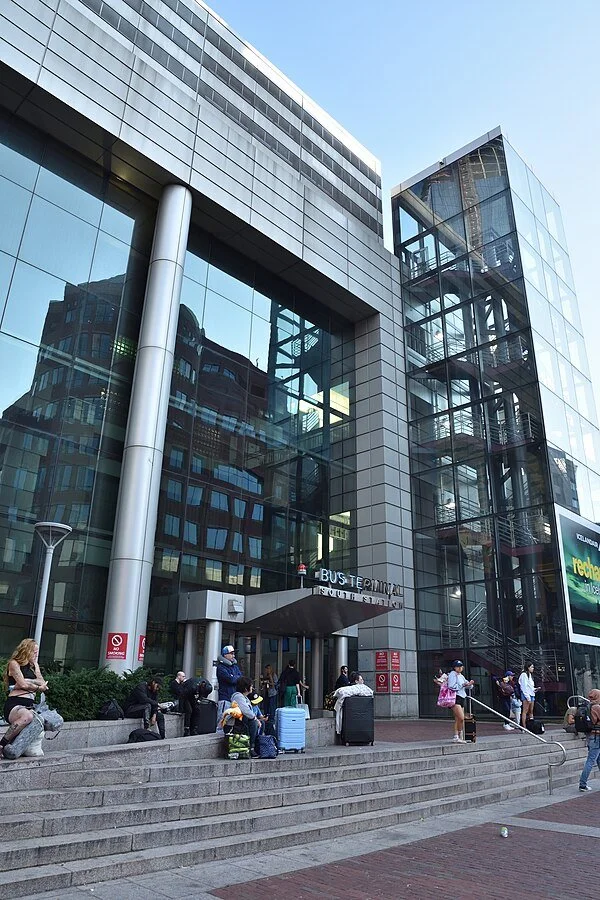
Keep this option alive
Boarding a Greyhound bus in downtown Salem, Ore., in 1964.
Entrance to the South Station Bus Terminal, in Boston, one of the nicest such facilities in America. That it is next to a big train station makes it even better. Sadly, many downtown bus terminals have been closed in the past few decades, with new ones, with minimal amenities, built next to windswept parking lots on the fringes of cities. Bus service is particularly important to low-and-middle-income people because bus tickets are obviously much cheaper than ones for plane and train travel.
Adapted from Robert Whitcomb “Digital Diary,’’ in GoLocal24.com
Speaking of deserts, reading a CNN report the other day about the dearth of bus terminals in America reminded me of how important bus lines are for millions of Americans, though the mass of our automobile-bound population doesn’t think about them much. Many bus passengers can’t drive because they can’t afford a car or their health doesn’t permit it. Others just don’t want to drive a car, maybe because they fear there are just too many dangerously bad drivers on the road or because they can snooze and read on a bus.
Certainly getting more people out of cars and into public transportation would be very good for our air quality.
Where the private sector is unable or unwilling to step in, the Feds, states and cities should subsidize the construction and maintenance of bus terminals because of their important social, economic and environmental roles. They remain an important, if unfashionable and old-fashioned, part of our transportation network
I used to take buses a lot, first to get to school and then commuting in and out of Boston and other cities. It wasn’t as comfortable as taking the train but was usually less stressful than driving. But being stuck in buses before smoking was banned there was nauseating.
We’re lucky in southern New England in having much more access to trains than most other Americans. And after so many years in which train lines were killed, some have even been revived in the past couple of decades. One example is the train service connecting Boston’s South Shore that was closed in 1959, forcing commuters in and out of Boston to use the new Southeast Expressway, which swiftly became a miles-long parking for hours a day. I remember from when I was a boy how much more pleasant it was to ride in those rattling old rail cars to Boston’s South Station from Cohasset than in claustrophobic buses with decayed suspensions; buses are generally much more comfortable now. Of course the buses would get stuck in traffic, too, even after the creation of bus lanes.
In any event, a version of the train service was revived in 2007, to the relief of thousands.
Democrats' takeover of House might presage greener light for Mass. rail-service expansion
The now-derelict place where the proposed Fall River MBTA station would go.
Adapted from Robert Whitcomb’s “Digital Diary,’’ in GoLocal24.com
Readers notice and maybe complain that I put a lot of public-transportation stuff in these columns. That’s because of its centrality in the prosperity of southern New England.
It’s good news for passenger-train expansion that the Democrats took the House in in mid-terms. Such pro-mass transit Massachusetts congressmen as Richard Neal and James McGovern will be in a position as committee chairmen to push for federal aid to boost such projects as rail service between Boston and Springfield and Boston and Fall River and New Bedford. Those would ease highway traffic and wear and tear on our roads, saving taxpayers time and money, and lift our region’s economy.
Purple lines show routes of proposed new MBTA lines to Fall River and New Bedford.
It will be tough to get anything helping New England through the GOP-controlled Senate, but a foundation (or rail bed) can be laid for when the political environment changes, perhaps after the 2020 elections.
Would Trump and the narrowly GOP Senate cooperate with the Democratic-run House in enacting a bill that would include the aforementioned projects? In his campaign, Trump talked up a huge infrastructure program but once in office pretty much dropped the subject and concentrated on giving himself and his pals a big tax cut and trying to kill the Affordable Care Act. But then the current version of the GOP sees tax cuts, particularly favoring the rich, as virtually their only domestic policy.
Still, a swelling federal deficit, an aging population, crumbling infrastructure and increased military spending pose huge challenges. My guess is that in the next few years, the top marginal federal income tax rate will have to be raised to around 50 percent to pay for the services the public wants (if not needs) and to address the rapidly swelling national debt and associated higher interest rates. The bond and stock markets are without mercy. We can’t live in financial Fantasyland forever.
Readers may email rwhitcomb4@cox.net to make comments.




